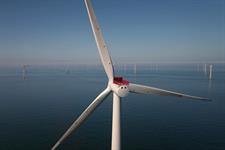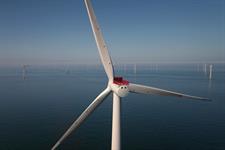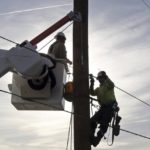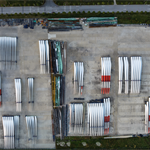Opinion: What might stop the UK hitting offshore wind goals?
Energy Disrupter

If everything goes smoothly, then the UK’s offshore wind industry should be well on track to hit the the government’s target of 40GW of generation capacity by 2030 — but this is not an industry that’s accustomed to everything going smoothly.
Chris Towner, Partner and renewable energy specialist at law firm Womble Bond Dickinson, looks at what needs to be done to ensure targets are hit.
The innovation and determination of the UK offshore wind sector has been proven time and again and has seen the country become the world leader in offshore wind generation.
An optimistic assessment of the UK’s offshore wind capacity — including current generation capacity (around 10.4GW), projects that are “under way”, plus the roughly 8GW worth of projects awarded in the fourth leasing round earlier this year — suggests that we ought to hit the 40GW by 2030 target with capacity to spare.
We saw more good news from our wind farms over the May 2021 bank holiday weekend as a new record for wind power generation was set in England, Scotland and Wales. Even if that relied on very strong wind conditions, it shows the capacity is there and we really are on the right track.
However, a pragmatic assessment of the task in hand would point to the many obstacles that remain in the way of these projects. If we have ambitions to hit the 2030 targets, and also to go beyond that and achieve net zero as a country by 2050, then many improvements must still be made to the way the industry operates, from project inception to completion.
And now is the time to start: with so many gigawatts of generation yet to be installed, here are some things to consider.
Can supply meet demand?
At the moment, there is greater demand for low-carbon projects ready to invest in than there is supply. We need a regulatory regime that brings more clean energy innovation projects swiftly through the system, to attract this investment to the UK and help to accelerate our decarbonisation goals.
The private sector is the key in all this – developers can deliver within the timescales, but only if a regime that enables this to happen is in place.
Permitting offshore wind projects
Key current concerns for projects include permitting risks, highlighted by the recent quashing of approval for Vattenfall’s Norfolk Vanguard offshore wind farm and certainty over the scale and timing of support from the contracts for difference (CfD) regime.
It is no secret that securing permitting for offshore wind farms is the most problematic aspect of the process. Project economics, technical constraints, supply chain capacity, social impact (aesthetics and amenity) and environmental impact must all be accounted for as part of the permitting process. It’s a complicated process that can cause significant delays — or cancellations — to projects as well as hugely increasing the risk for investors.
It’s also far from a new issue: the rate at which permitting is secured has always hamstrung the UK offshore wind sector and threatened progress.
Due consideration absolutely must be given to the impact that offshore wind farms have — whether that’s on the marine bed, the animal, marine and bird life around them, the point at which they connect to the land, the people that live nearby. But this can and must be done with more speed and less obstacles than it currently is. There needs to be a balance between all of these interests. With the experience we have accumulated to date, finding that balance should be faster, not slower than for previous projects.
Without major improvements to the way permitting is handled for offshore wind farm projects, the 2030 target could be missed. Many of these barriers can only be overcome with improved collaboration between industry, consultees, and regulators.
The sheer size of the scale-up required
UK offshore wind capacity went from around 1GW in 2010 to just over 10GW by 2020. Undoubtedly great progress, but that effort needs to be more than trebled over the next nine years to hit the target.
Aurora Energy Research suggests this will require the equivalent of a 10-12MW turbine being installed every weekday throughout this decade, along with around £50 billion (€58 billion) of investment and a further 20GW of leasing rounds within the next few years.
We’re going to need more rounds.
The offshore wind projects currently under way are almost certainly going to be enough to hit the 2030 target — barring any hitches — but more rounds would still be beneficial to the industry and will contribute to whatever targets are set beyond 2030.
It’s unrealistic to expect that they will all be on the same scale as the fourth leasing round — especially bearing in mind the value of the bids involved there — so perhaps a “micro” approach to leasing from the Crown Estate will be the way forward, offering more frequent but smaller rounds.
Infrastructure – both onshore and offshore
The current system whereby each array connects to the land via its own infrastructure, complete with onshore substation, isn’t sustainable. Some of the biggest permitting issues focus on the onshore connection points and communities.
The most likely solution to reduce the number of points at which our offshore wind farms have to make landfall lies in the development of an offshore grid network but, again, this will require colossal investment and collaboration.
Likewise, the rest of the onshore grid is currently not geared up to support offshore generation: significant investment in the onshore infrastructure will be required to ensure that the power being generated can reach people’s homes and businesses. This work involves land purchases for linear infrastructure schemes — which can be complex projects involving multiple landowners,. with the potential to cause delays and disruption.
Can the CfD scheme cover its own obligations?
The CfD scheme has played a major role in the success of our offshore wind industry to date, but Aurora Energy Research also estimates that increasing installed capacity to 40GW would cost a further £2.6bn per year in CfD top-up payments – almost five times the allocated budget – in the initial years of those CfDs.
This shortfall could be a political challenge as the cost will be funded by consumers. The evolution of the CfD scheme will be of major focus to the industry over the coming years. There are proposed changes aiming to ensure only competitive renewables projects receive government backing. If the strike prices for offshore wind remain at around £40/MWh, that is still substantially lower than the costs of nuclear (£92.50/MWh) and the projected costs of carbon capture and storage.
It remains to be seen, however, whether the price certainty offered by a CfD, so valuable for investors, will offset the potential for wasted development costs in meeting CfD criteria but not being successful in the auction process – particularly for smaller scale technologies. Some onshore wind and solar projects may opt not to participate in the process. We also await details of the overall budget allocation and how this is to be split between pots.
Regional offshore wind differences
Largely due to the differing legal regimes in the devolved administrations in the UK, the process involved in securing permits varies greatly depending on the nation in which you’re applying.
In England, a development consent order is granted under the Planning Act 2008. This order incorporates a number of consents, including a marine licence and onshore consents. In Wales the marine licence is determined by Natural Resources Wales. In Scotland, Marine Scotland examines applications for the offshore works while Scottish ministers grant or refuse consent under the Marine (Scotland) Act 2010 — up to 12 nautical miles (22.2km) from shore — and the Marine and Coastal Access Act 2009 for projects 12-200 nm (22.2-370.4km) from shore.
It would certainly be simpler for everyone if these differences could be ironed out, but in the current political climate it’s unlikely to be resolved quickly.
Skilled worker shortage
Most industries are battling skills shortages right now, and offshore wind is no exception.
As we transition away from traditional oil and gas-based power generation, the need to bring through new, skilled labour – a green-ready workforce – is placing even greater onus on schools, colleges, and universities to deliver in STEM subjects (science, technology, engineering and mathematics).
What can be done?
This is just an overview of some of the challenges that the offshore industry faces as it seeks to hit those 2030 targets. It’s not intended to be pessimistic. Instead horizon scanning and looking at the challenges ahead as we continue to support projects across the UK is intended to help the post pandemic rebuild to be carried out in a sustainable way.
Improved collaboration by all stakeholders and a willingness to have open and honest discussions about what needs to be done and the balance of interests — and acting upon those conversations — should get us over the line. Private-sector funds are available to drive innovation for renewables forward and will play a big part in continuing the UK success story as world leader.
It’s also worth remembering that 2030 is not the end goal here. The greater challenge is lifting our sights to the 2050 net zero target and the likely doubling of demand for electricity that will entail, as domestic heating and transportation is electrified. Tackling each of the issues mentioned above, will only help the UK to achieve that greater ambition.
















